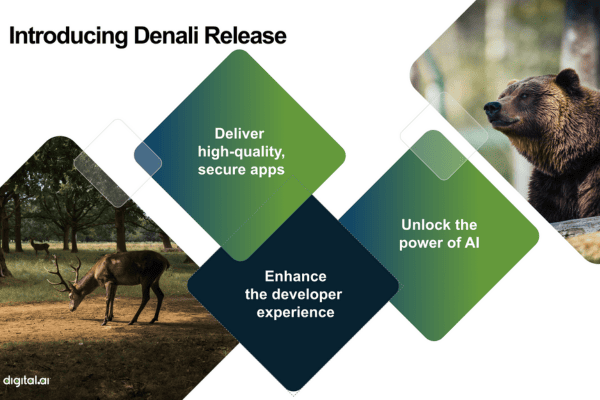Written by Silvia Davis
“Improvement work is never done. Find a bottleneck in your system, address it, and repeat the process.”
This particular phrase from the 2023 Accelerate State of DevOps Report has become a personal favorite of mine. Why? Well, it underscores the notion that enhancing our work methods isn’t a one-time effort but an ongoing process. We must consistently adapt to the ever-shifting environment without falling prey to the fatigue that constant change can bring about.
The DevOps Research and Assessment (DORA) Community, led mainly by Google, recently released the new Accelerate State of DevOps Report 2023. The report has been coming out for almost a decade, and its goal is to show how companies are getting better at delivering software and operational performance by applying new ways of working. It contains important data points that predict trends, set benchmarks, and provide a wealth of insights. These insights offer valuable parameters for assessing your position in your software delivery journey and identifying key areas for ongoing improvements.
The report says, “Adopting a mindset and practice of continuous improvement are likely to see the most benefits for companies. DORA can help influence customers’ improvement initiatives to increase not only software delivery performance but also operational and team performance.”
The key to success for companies is always looking for ways to improve. DORA (DevOps Research and Assessment) can help companies with this by encouraging them to improve software delivery and make their operational process and teams work better.
The report also talks about how teams that learn the most tend to improve the most. The focus should not solely be on comparing and quantifying processes or team improvements; instead, metrics should serve as a means to enhance empathy, collaboration, and a deeper understanding of each participant’s motivations.
According to the survey, when information flows easily, things get done better. Sharing information more often is linked to better software delivery and operations, and it can reduce employee burnout. When information is easy to find, and there aren’t knowledge silos, people can spend more time on important tasks instead of searching for information all the time to perform those tasks.
The report correlates various organizational, team, and employee data points. Here are important points to keep in mind:
- Organizational Performance: The organization should produce not only revenue but also value for customers and the extended community.
- Team Performance: The ability of an application or service team to create value, innovate, and collaborate.
- Employee Well-Being: The strategies an organization or team adopts should benefit the employees—reduce burnout, foster a satisfying job experience, and increase people’s ability to produce valuable outputs (productivity).
Another aspect of the report is the key metrics the DORA community has shared for years. Here are the metrics to remind you:
- Software Delivery Performance: Teams can change their technology systems safely, quickly, and efficiently. It includes:
- Lead Time for Changes: What is your lead time for changes for the primary application or service you work on (i.e., how long does it take to go from code committed to code successfully running in production)?
- Failed Deployment Recovery Time: Formerly using the Mean Time to Repair (MTTR) metric – now changed to Failed Deployment Recovery Time. The new metrics refer to the primary application and how long it generally takes to restore it when a service incident or a defect impacting users occurs (e.g., failed deployment, failed change.
- Deployment Frequency: For the primary application or service you work on, how often does your organization deploy code to production or release it to end users?
- Change Failure Rate: For the primary application or service you work on, what percentage of changes to production or released to users result in degraded service (e.g., lead to service impairment or service outage) and subsequently require remediation (e.g., require a hotfix, rollback, fix forward, patch)?
- Operational Performance – Reliability: The service provides a reliable user experience.
Key Findings of the Report
- Establish a Healthy Culture: Culture is foundational – Teams with generative cultures have 30% higher organizational performance.
- Build with Users in Mind: Teams focusing on users have 40% higher organizational performance.
- Unlock Software Delivery Performance with Faster Code Reviews: Teams with faster code reviews have 50% higher software delivery performance.
- Amplify Technical Capabilities with Quality Documentation: Trunk-based development with high-quality documentation is estimated to have 12.8x more impact on organizational performance.
- Increase Infrastructure Flexibility with Cloud: Infrastructure flexibility can lead to 30% higher organizational performance than inflexible infrastructures.
- Balance Delivery Speed, Operational Performance, and User Focus: You need both strong software delivery and operational performance balanced with a user focus for organizational performance to see its fullest potential.
- Distribute Work Fairly: Respondents who take on more repetitive work are more likely to experience higher levels of burnout, and members of underrepresented groups are more likely to take on more repetitive work. Watch out for the unbalanced work distribution for underrepresented groups.
Conclusion
“None of this works without investing in culture; teams with generative culture have 30% higher organizational performance.”
Culture is a key driver of employees’ well-being and organizational performance. A healthy culture can help reduce burnout, increase productivity, and increase job satisfaction. Thus, the key takeaway for the 2023 report is that leveraging a Westrum Generative Culture is foundational for companies that want to increase organizational and team performance.
Accomplishing this involves aligning culture with practices and practices with culture. A healthy culture contributes to high employee well-being, reducing burnout, increasing job satisfaction, and boosting productivity. Employee well-being is not optional but essential for an organization’s overall health and success. Achieving a sense of belongingness within the organization is a continuous effort, emphasizing the importance of sustained experience and action for workplace health and productivity.
Interested in what DevOps practices drive successful software delivery and operational performance? Download the full Accelerate State of DevOps 2023 Report to learn more.
Are you ready to scale your enterprise?
Explore
What's New In The World of Digital.ai
How DevOps and AI Together Maximize Software Delivery Efficiency
Explore the transformative power of AI and ML in DevOps. Predict delays, avoid software change failure, and leverage solution patterns for a more efficient SDLC.
Key Findings from the Accelerate State of DevOps Report 2023
Unlock insights from the 2023 Accelerate State of DevOps Report and start enhancing software delivery, operations, and team well-being for sustained success.
Denali Release
Explore the Denali Release: Digital.ai’s Latest AI-Powered DevSecOps Platform! Dive deep into new features, AI integrations, and secure application delivery at scale.



